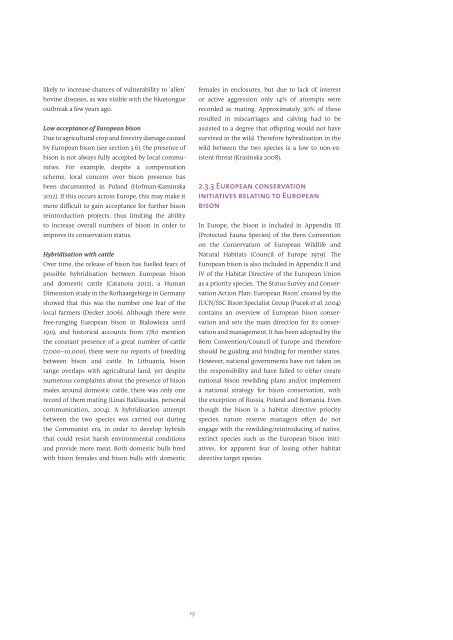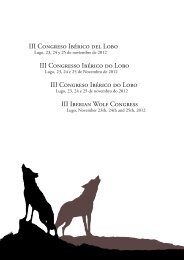2.3Current conservation statusRecent globalpopulation estimatesfor free-ranging(un-fenced) Europeanbison (<strong>Bison</strong> bonasus)2.3.1 Global conservation assessmentThe IUCN Red List of Threatened Species currentlylists the European bison as Vulnerable. In additionto this, it distinguishes between the two geneticlines: the Lowland line (B. b. bonasus) and theLowland-Caucasian line (B. b. bonasus and B. b.caucasicus). The Lowland bison line is consideredVulnerable based on data from 2000, when thetotal population was 931 individuals. Although thepopulation declined between the early 1990s and2000, it is currently increasing. The Lowland-Caucasianline is considered Endangered based ondata from 2000, when the total population was714 individuals. The population decreased by 20%between 1990 and 2000, and has continued todecline since 2000.A population estimate from 2011, withadditional information from 2013, put thepopulation of free-ranging European bison at2,371 individuals. At the country level, strongholdsfor the species exist in Poland (36%), Belarus(34%) and Russia (17%), with smaller populationsin Ukraine (9%), Lithuania (2%), Romania (< 1%),Germany (< 1%), Slovakia (< 1%) and Latvia (< 1%)(Table 1).The current pedigree book (EBPB 2012) reportsthe global population of European bison as 4,987individuals. However, data on European bisonpopulations as of 31 December 2012 were publishedin <strong>2014</strong> and in accordance with data obtainedfrom personal communication with breeders thisnumber now stands at 5,046, with the numberof individuals living in captivity at 1,643 and thenumber of individuals from free and semi-freeherds at 3,403 (Magda Trzeciak, personal communication,<strong>2014</strong>).EstimatedpopulationYearassessedReferenceGlobal/Europe 3,230 2013 EBPB 2012; EBCC 2013, <strong>2014</strong>Belarus (Lowland) 1,146 2013 EBPB 2012; EBCC 2013Germany (Lowland-Caucasian) 10 2013 Van de Vlasakker 2013Latvia (Lowland) 12 2013 EBPB 2012Lithuania (Lowland) 82 2013 EBPB 2012; EBCC 2013Poland (Lowland Caucasianin Bieszczady)1,138 <strong>2014</strong> EBPB <strong>2014</strong>; EBCC <strong>2014</strong>Romania (Lowland-Caucasian) 21 2013 Deju 2013; EBPB 2012Russia (Lowland-Caucasian) 556 2013 EBPB 2012; EBCC 2013Slovakia (Lowland-Caucasian) 15 2013 EBPB 2012; EBCC 2013Ukraine (Lowland-Caucasian) 250 2013 EBPB 2012; EBCC 20132.3.2 Current threats to EuropeanbisonInsufficient habitatEuropean bison continue to lack the space requiredfor viable populations. Most conservation effortsare still focussing outside the species’ optimumrange and are mainly concentrated in forestedand mountainous habitats (see section 3.2). This islargely because across Europe, suitable habitat forEuropean bison generally coincides with regionsthat support high human populations, e.g. rivervalleys and lowland areas with productive soils.Small population sizeSmall population size is also a major threat to thelong-term viability of European bison populations.Most contain fewer than 50 individuals, despite thefact that the minimum viable population size hasbeen estimated at 1,000 individuals (Perzanowskiet al. 2004; Pucek et al. 2004). The species has lowgenetic diversity due to all modern populationsbeing descended from only 12 founder individuals(Olech and Perzanowski 2002; Pucek et al. 2004) andthe genetic contribution of the 12 founders is alsouneven, highly dominated by one pair. The mixingof both Lowland and Lowland-Caucasian lines ofEuropean bison has also locally led to the loss offounder genes specific to the Lowland-Caucasianline.DiseaseThe limited genetic heterogeneity, low numbers andlack of natural selection might all have contributedto the species’ weak resistance to diseases (Pucek2004, van de Vlasakker 2008). An important disease,balanoposthitis, affects the male reproductiveorgans and is manifested in the inflammation ofthe penis and prepuce. Despite years of study, itspathogenesis has not yet been clarified (Pucek et al.2004). Parasitic diseases remain a serious threat tothe present population. <strong>Bison</strong> that receive supplementaryfeeding show higher parasite infestationdue to concentration of bison and subsequentdefecation at fixed feeding locations, combinedwith more sedentary behaviour encouraged bysupplementary feeding (Radwan et al. 2010; Pyziel etal. 2011). Viral (foot and mouth disease) and bacterialdiseases (tuberculosis) can also be transferred fromdomestic cattle to bison, and it is these diseaseswhich are the most dangerous for the bison. Lownumbers of bison in combination with additionalstress factors such as climate change are also18
likely to increase chances of vulnerability to ‘alien’bovine diseases, as was visible with the bluetongueoutbreak a few years ago.Low acceptance of European bisonDue to agricultural crop and forestry damage causedby European bison (see section 3.6), the presence ofbison is not always fully accepted by local communities.For example, despite a compensationscheme, local concern over bison presence hasbeen documented in Poland (Hofman-Kaminska2012). If this occurs across Europe, this may make itmore difficult to gain acceptance for further bisonreintroduction projects, thus limiting the abilityto increase overall numbers of bison in order toimprove its conservation status.Hybridisation with cattleOver time, the release of bison has fuelled fears ofpossible hybridisation between European bisonand domestic cattle (Catanoiu 2012); a HumanDimension study in the Rothaargebirge in Germanyshowed that this was the number one fear of thelocal farmers (Decker 2006). Although there werefree-ranging European bison in Bialowieza until1919, and historical accounts from 1780 mentionthe constant presence of a great number of cattle(7,000–10,000), there were no reports of breedingbetween bison and cattle. In Lithuania, bisonrange overlaps with agricultural land, yet despitenumerous complaints about the presence of bisonmales around domestic cattle, there was only onerecord of them mating (Linas Balčiauskas, personalcommunication, 2004). A hybridisation attemptbetween the two species was carried out duringthe Communist era, in order to develop hybridsthat could resist harsh environmental conditionsand provide more meat. Both domestic bulls bredwith bison females and bison bulls with domesticfemales in enclosures, but due to lack of interestor active aggression only 14% of attempts wererecorded as mating. Approximately 30% of theseresulted in miscarriages and calving had to beassisted to a degree that offspring would not havesurvived in the wild. Therefore hybridisation in thewild between the two species is a low to non-existentthreat (Krasinska 2008).2.3.3 European conservationinitiatives relating to EuropeanbisonIn Europe, the bison is included in Appendix III(Protected Fauna Species) of the Bern Conventionon the Conservation of European Wildlife andNatural Habitats (Council of Europe 1979). TheEuropean bison is also included in Appendix II andIV of the Habitat Directive of the European Unionas a priority species. ‘The Status Survey and ConservationAction <strong>Plan</strong>: European <strong>Bison</strong>’ created by theIUCN/SSC <strong>Bison</strong> Specialist Group (Pucek et al. 2004)contains an overview of European bison conservationand sets the main direction for its conservationand management. It has been adopted by theBern Convention/Council of Europe and thereforeshould be guiding and binding for member states.However, national governments have not taken onthe responsibility and have failed to either createnational bison rewilding plans and/or implementa national strategy for bison conservation, withthe exception of Russia, Poland and Romania. Eventhough the bison is a habitat directive priorityspecies, nature reserve managers often do notengage with the rewilding/reintroducing of native,extinct species such as the European bison initiatives,for apparent fear of losing other habitatdirective target species.19



